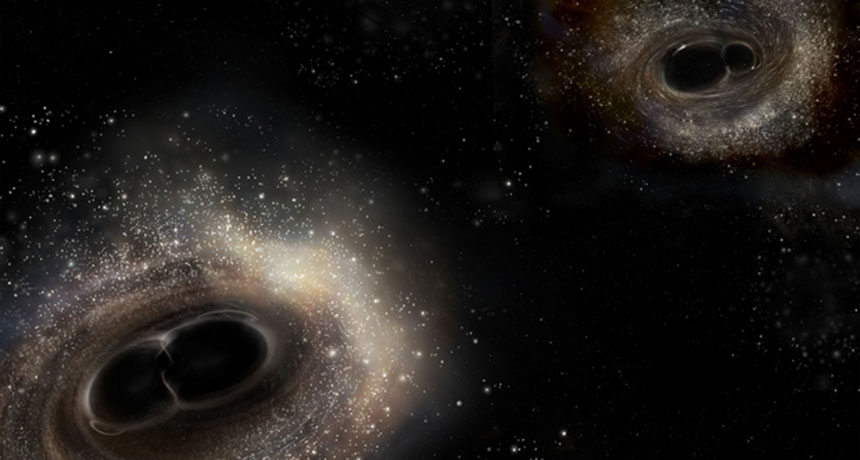
DUOS’ DANCE Mergers of two pairs of black holes (illustrated) showcase ability of gravitational waves as a new tool for understanding the universe. LIGO detected gravitational waves from both mergers shown, but at different times and in different parts of the sky.
A. Simonnet/LIGO
- More than 2 years ago
SAN DIEGO — While astrophysicists celebrate the second detection of ripples in spacetime (SN Online: 6/15/16), they are also looking ahead to figuring out what led to these cosmic quakes. Black holes colliding in remote galaxies sent the gravitational waves our way. But how these duos ended up in an ill-fated embrace in the first place is unknown.
With only two clear detections from the Advanced Laser Interferometer Gravitational-Wave Observatory, and a third marginal candidate, there isn’t enough information to figure out for sure how these binary black holes formed. But there are two leading ideas.
One is that two heavyweight stars, each more than roughly 20 times as massive as the sun, are born, live and detonate together. Their deaths would leave behind a pair of black holes snuggled up to one another. They would eventually spiral together in a spectacular collision (SN: 3/19/16, p. 5).
Another idea is that the black holes find each other in the hustle and bustle of a dense star cluster. Within these crowded clusters, stars and black holes gravitationally shove each other around. “My graduate student calls it a black hole mosh pit,” Frederic Rasio, an astrophysicist at Northwestern University in Evanston, Ill., said June 15 during a news briefing at a meeting of the American Astronomical Society.
Rasio and colleagues developed computer simulations that investigate how denizens of these clusters interact with one another. Black holes settle into the center of the cluster, where some get caught in another’s gravitational embrace. Continued run-ins with other wandering black holes fling these pairings from the cluster, leaving the couple to soar across the galaxy and eventually merge into a single black hole.
There’s no way to tell if the two black hole pairs found by LIGO formed as stellar siblings or cluster cousins. But tests could be done as more are found.
Measuring the spins of the black holes could distinguish between formation scenarios, says Rasio. Black holes from previously paired stars will be spinning the same way; those that hooked up in a star cluster are more likely to be spinning in random directions. While LIGO researchers report that one of the black holes in the latest detection was twirling, they can’t tell which one it was or which way its spin axis was pointing.
Another test requires finding collisions over a range of distances from Earth. Because it takes time for gravitational waves to reach us, more distant impacts happened earlier in cosmic history. If astronomers notice an uptick in collisions happening around the same time that star formation peaked in the early universe, then pairings of massive stars are the more likely culprit, says Vicky Kalogera, an astrophysicist also at Northwestern.
“This has great potential to tell us how binary black holes formed,” she says. “But we need a larger sample.”
With improved detectors, researchers could eventually listen in on the entire observable universe — and all of cosmic history back to the first wave of star formation. “Big black holes come from big stars,” says Jonah Kanner, a Caltech astrophysicist. And the first stars are thought to have been hundreds of times more massive than our sun. If LIGO had 10 times its current sensitivity, he says, “we could learn about the first generation of stars. That’s exciting astrophysics.”
Such a leap would require a much more ambitious facility, such as a souped-up LIGO with 40-kilometer-long arms, says Kanner (today’s LIGO is one-tenth that size). “That’s the kind of concept where I can daydream,” he says. It’s just a pipedream for now, but over the coming years, new observatories will come online and bring with them incremental improvements in how far researchers can probe.
LIGO itself is undergoing an upgrade, and will be switched back on this fall. The VIRGO detector in Italy should return to service in early 2017 after five-plus years of refurbishment. In Japan, the KAGRA facility is under construction with plans to begin operation in 2018. And the Indian government recently gave the go-ahead to build a third LIGO facility.
“This is just the beginning of gravitational wave astronomy,” said VIRGO spokesperson Fulvio Ricci, a physicist at the Sapienza University of Rome. “We did it, then we did it again, and we will do it again in the future.”







